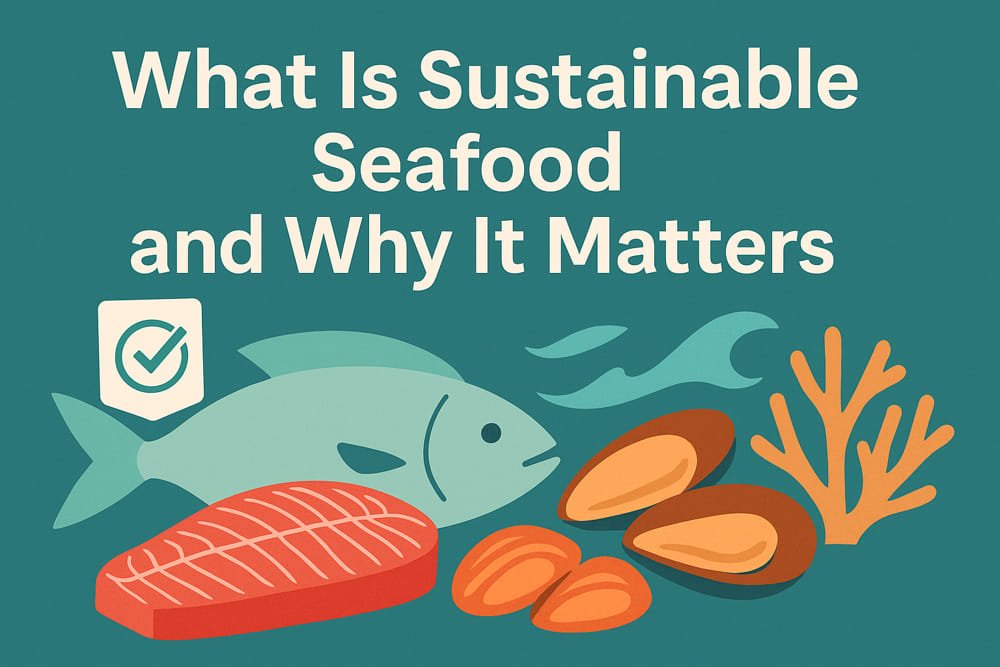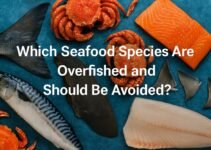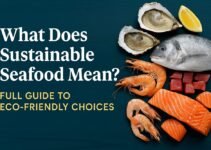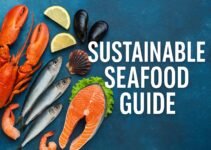As the global population grows and seafood consumption increases, the demand placed on the world’s oceans has never been higher. Overfishing, habitat destruction, and unsustainable aquaculture practices are threatening marine biodiversity and food security. In response, “sustainable seafood” has emerged as a crucial concept for preserving ocean health while ensuring seafood remains a viable resource for future generations.
But what exactly does “sustainable” mean in the context of seafood? And why should everyday consumers care about the source of their fish and shellfish?
This article explores the meaning behind sustainable seafood, why it matters for the planet and people, and how to make informed, responsible choices as a consumer. Whether you’re a home cook, a chef, or simply someone who enjoys seafood, understanding sustainability in this industry empowers you to eat with awareness—and impact.
Contents
What Is Sustainable Seafood?
Sustainable seafood refers to fish and shellfish that are caught or farmed in ways that maintain healthy populations, protect ecosystems, and support the livelihoods of people who depend on the ocean. It is a balance between meeting current seafood needs and ensuring the long-term health of marine environments.
Key principles of sustainable seafood include:
- Environmental Responsibility: Fishing practices must avoid overfishing, minimize bycatch (unintentional catch of non-target species), and protect sensitive habitats such as coral reefs and seagrass beds.
- Effective Management: Fisheries and aquaculture operations should be well-regulated, monitored, and enforced by science-based policies and local authorities.
- Traceability and Transparency: Consumers and suppliers should be able to trace seafood to its source, ensuring it was harvested legally and ethically.
Sustainable seafood can come from both wild-caught and farmed sources. When managed properly, aquaculture (fish farming) can be an environmentally friendly alternative that reduces pressure on wild fish stocks. However, poorly regulated operations can lead to water pollution, disease spread, and ecosystem damage.
Why Sustainable Seafood Matters
1. Protecting Marine Ecosystems
Unsustainable fishing methods, such as bottom trawling or illegal fishing, damage delicate marine habitats and deplete fish populations at alarming rates. This disrupts entire ecosystems, causing ripple effects throughout the ocean’s food chain. Sustainable practices prioritize ecological balance, helping oceans regenerate and remain resilient.
2. Supporting Economic Stability
Sustainable seafood practices safeguard the long-term viability of fishing communities. Overfishing may bring short-term profits, but it leads to stock collapse and economic loss in the long run. Supporting responsible fisheries helps create stable, long-lasting jobs and strengthens coastal economies.
3. Empowering Informed Consumption
Consumers today are increasingly aware of where their food comes from. Choosing sustainable seafood means aligning your values with your purchases. It reduces demand for destructive fishing, encourages accountability, and helps protect the rights of workers in the seafood supply chain.
In short, sustainable seafood isn’t just an environmental issue—it’s a social, economic, and ethical responsibility that affects us all.
How to Identify Sustainable Seafood
Navigating seafood labels and sourcing can be confusing, especially for everyday shoppers. Fortunately, several tools and certifications exist to help consumers make more informed, sustainable choices.
1. Look for Trusted Eco-Labels
Certifications are among the most reliable indicators of sustainability. Some of the most recognized labels include:
- Marine Stewardship Council (MSC): For wild-caught seafood, the MSC blue label indicates that the fishery has been independently assessed for environmental performance, traceability, and long-term sustainability.
- Aquaculture Stewardship Council (ASC): Focused on farmed seafood, the ASC green label assures responsible aquaculture that limits pollution, antibiotic use, and habitat damage.
- Best Aquaculture Practices (BAP): Covers the entire seafood production chain—from hatcheries to processing—ensuring ethical treatment of both fish and workers.
2. Use Seafood Ratings and Apps
Organizations like the Monterey Bay Aquarium’s Seafood Watch offer regional guides and mobile apps that rate seafood based on sustainability. These resources help you choose “Best Choices” and avoid “Red List” species with high ecological impact.
3. Ask the Right Questions
When shopping or dining out, asking a few key questions can reveal a lot:
- Is this seafood wild-caught or farmed?
- Where was it sourced from?
- Is it certified or rated by a sustainability organization?
Sustainable seafood is often traceable. Transparency from suppliers is a good sign that responsible practices are in place.
Best Sustainable Seafood Choices
Not all seafood options carry the same environmental weight. Some species are naturally more sustainable due to their fast growth rates, low environmental impact, or responsible farming techniques.
1. Shellfish: Mussels, Oysters, and Clams
These bivalves are some of the most sustainable choices available. They require no feed, help filter and clean the water around them, and can even improve the health of their surrounding ecosystems. Farmed mussels and oysters are especially low-impact.
Scallops, another popular shellfish, are also widely consumed—especially raw in certain cuisines. If you’re curious about food safety in such cases, read our detailed guide on whether it’s safe to eat scallops raw.
2. Small, Fast-Growing Fish: Sardines, Anchovies, and Mackerel
These species reproduce quickly and exist lower on the food chain, which means harvesting them causes less disruption to marine ecosystems. Many are also rich in omega-3 fatty acids, offering nutritional value along with sustainability.
3. Responsibly Farmed Seafood: Arctic Char, Barramundi, Rainbow Trout
When farmed in land-based systems or closed-loop aquaculture, these species pose fewer risks to the environment than traditional open-water fish farms. Look for ASC or BAP certifications when purchasing farmed options.
4. Local and Seasonal Choices
Buying seafood that’s in season and sourced locally reduces transportation emissions and supports nearby fisheries. Local doesn’t always mean sustainable, but it’s a good starting point—especially when combined with other responsible practices.
Common Myths About Sustainable Seafood
Sustainable seafood is a growing movement, but it’s often misunderstood. Here are some of the most persistent myths—and the facts that debunk them.
Myth 1: Wild-caught is always better than farmed
Fact: While wild-caught fish can be sustainable, some farmed options are actually better for the environment. Responsible aquaculture helps reduce pressure on wild stocks and can be carefully managed to minimize ecological impact.
Myth 2: Sustainable seafood is too expensive
Fact: While some certified options may cost more, others—like mussels or sardines—are affordable and highly sustainable. The market is also expanding, which helps lower prices over time.
Myth 3: All eco-labels mean the same thing
Fact: Not all certifications hold the same standards. It’s important to look for credible labels like MSC, ASC, or BAP, and to understand what each one guarantees.
Myth 4: It’s too hard to find sustainable seafood
Fact: With digital tools, eco-guides, and increasing retailer awareness, sustainable seafood is more accessible than ever. Many supermarkets now label sustainable options, and online seafood suppliers often provide traceability data.
How You Can Support Sustainable Seafood
You don’t have to be a marine biologist or seafood expert to make a difference. As a consumer, your purchasing decisions carry real influence—and even small changes in your habits can contribute to a healthier ocean.
1. Diversify Your Choices
Many people consume only a handful of popular species like shrimp, salmon, and tuna, putting immense pressure on these stocks. Expanding your seafood palate to include underutilized or local species (like mackerel, sardines, or dogfish) can ease that strain and support more balanced ecosystems.
2. Eat Seasonally and Locally When Possible
Just like fruits and vegetables, some seafood is more sustainable when consumed in season. Seasonal seafood tends to be fresher, has a lower carbon footprint, and supports regional fisheries that often follow more transparent and traceable practices.
3. Reduce Waste and Use Seafood Wisely
Maximize the value of your seafood purchases by storing them properly and using the entire product when possible. Leftover fish can be repurposed into soups, salads, or spreads, reducing food waste and improving sustainability at the household level.
4. Support Ethical Retailers and Restaurants
Choose to buy from suppliers who are transparent about sourcing and certified by credible bodies. Dining at restaurants that participate in sustainability programs or use eco-certified seafood also amplifies your impact.
Future of Sustainable Seafood
The road ahead for sustainable seafood is both challenging and promising. Global awareness is rising, technologies are improving, and consumer habits are gradually shifting toward more responsible choices—but significant work remains.
1. Innovation in Aquaculture
The future of seafood may lie in smart, scalable aquaculture. Innovations like land-based recirculating aquaculture systems (RAS) and offshore fish farms are helping reduce environmental impact while meeting global demand. These closed systems recycle water, minimize pollution, and allow for tighter control of feed and waste.
2. Digital Traceability and Blockchain
Advanced tracking tools, including blockchain technology, are revolutionizing seafood traceability. These tools ensure that each product’s journey—from ocean to plate—is transparent, tamper-proof, and verifiable. This combats seafood fraud and illegal fishing while building consumer trust.
3. Policy and Global Collaboration
Sustainable seafood also depends on sound government regulations, international cooperation, and enforcement. Effective marine management—like catch limits, protected areas, and community-based fishing rights—ensures that sustainability is not just a marketing label but a legally and scientifically backed commitment.
4. The Role of Conscious Consumers
Ultimately, sustainability thrives when demand aligns with ethics. The future of seafood lies not just in the ocean but in the hands of consumers who choose wisely, ask questions, and advocate for change.
Conclusion
Sustainable seafood is more than just a buzzword—it’s a necessary movement toward protecting our oceans, supporting local communities, and ensuring that future generations can enjoy the bounty of the sea. By understanding what sustainable seafood means and making informed choices, each of us can play a vital role in safeguarding the marine environment.
Whether it’s selecting eco-certified products, diversifying your seafood meals, or simply asking where your fish comes from, your choices matter. A healthier ocean begins at your dinner table.



